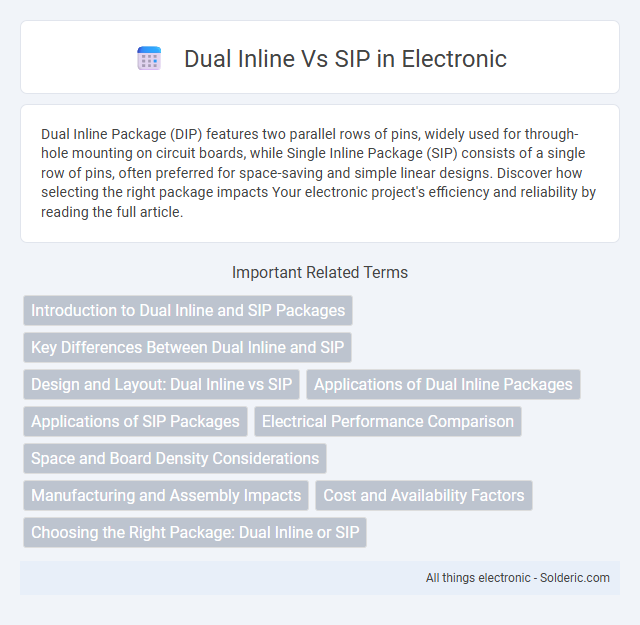Dual Inline Package (DIP) features two parallel rows of pins, widely used for through-hole mounting on circuit boards, while Single Inline Package (SIP) consists of a single row of pins, often preferred for space-saving and simple linear designs. Discover how selecting the right package impacts Your electronic project's efficiency and reliability by reading the full article.
Comparison Table
| Feature | Dual Inline Package (DIP) | Single Inline Package (SIP) |
|---|---|---|
| Pin Configuration | Two parallel rows of pins | One single row of pins |
| Pin Count | Typically 8 to 64 pins | Usually 4 to 20 pins |
| Size | Wider due to double rows | Narrower, more compact |
| Mounting | Through-hole mounting | Through-hole mounting, often for resistors or SIP modules |
| Usage | Common for ICs, microcontrollers | Used for resistor arrays, filters, and some memory modules |
| Ease of Handling | Easy to handle and test due to spaced pins | Compact, less spaced pins, harder to handle |
| Cost | Generally higher due to complexity | Lower cost, simpler structure |
Introduction to Dual Inline and SIP Packages
Dual Inline Package (DIP) features two parallel rows of pins ideal for through-hole mounting on printed circuit boards, offering robust mechanical strength and ease of prototyping. Single In-line Package (SIP) consists of a single row of pins, commonly used for resistors or diodes, saving board space while simplifying layout design. Your choice between Dual Inline and SIP packages depends on component density requirements and mechanical constraints in electronic circuit design.
Key Differences Between Dual Inline and SIP
Dual Inline Packages (DIP) feature two parallel rows of pins designed for through-hole mounting, commonly used in microcontrollers and integrated circuits. Single Inline Packages (SIP) consist of a single row of pins, allowing for simplified PCB design and typically used in resistors or memory modules. The primary distinctions lie in pin configuration, mounting style, and typical applications, with DIPs offering higher pin counts and SIPs providing a more compact footprint.
Design and Layout: Dual Inline vs SIP
Dual Inline Package (DIP) features two parallel rows of pins extending perpendicularly from a rectangular housing, enabling through-hole mounting on PCBs with standardized hole spacing for robust mechanical stability. Single In-line Package (SIP) offers a single row of pins aligned linearly, minimizing PCB area usage and simplifying insertion for applications requiring fewer connections. DIP's dual-row design supports higher pin counts and easier socketing, while SIP's streamlined layout benefits compact, linear component arrangements in constrained spaces.
Applications of Dual Inline Packages
Dual Inline Packages (DIPs) are widely used in prototyping, educational kits, and through-hole PCB assemblies due to their ease of manual insertion and soldering. They are commonly found in microcontrollers, operational amplifiers, and memory modules, supporting applications that benefit from robust mechanical connections. The DIP format allows straightforward replacement and testing of components in embedded systems and industrial equipment.
Applications of SIP Packages
SIP (Single In-line Package) components are widely used in applications requiring simple, space-efficient designs such as telecommunications, audio amplifiers, and power regulators. Their linear pin configuration allows for easy insertion into circuit boards, making them ideal for compact, modular electronic devices and prototypes. SIP packages are preferred in power supply modules and signal processing circuits where thermal management and straightforward PCB layout are crucial.
Electrical Performance Comparison
Dual Inline Packages (DIP) provide superior electrical performance with lower parasitic inductance and capacitance compared to Single Inline Packages (SIP), resulting in better signal integrity at higher frequencies. DIPs feature symmetrical pin arrangements on both sides, enabling balanced current flow and reduced crosstalk, whereas SIPs with pins on only one side often suffer increased noise and signal degradation. The improved thermal dissipation in DIPs also contributes to stable electrical characteristics during extended operation, making them preferable for high-speed and precision analog circuits.
Space and Board Density Considerations
Dual Inline Package (DIP) components offer a two-row pin configuration that allows moderate board density but require more PCB space compared to Single Inline Package (SIP) components, which have a single row of pins and enable higher packing density on printed circuit boards. Choosing SIP can maximize your board space efficiency, especially in designs where compactness is critical, as SIPs reduce the footprint while maintaining simplified routing. Careful evaluation of your project's space constraints and electrical requirements will guide the optimal package selection to balance performance and layout density.
Manufacturing and Assembly Impacts
Dual Inline Package (DIP) components offer streamlined manufacturing with easy manual insertion and compatibility with automated wave soldering processes, reducing assembly time and costs. Single Inline Package (SIP) components, featuring a single row of pins, provide a compact footprint that can improve PCB layout efficiency but may require more precise alignment during assembly. Choosing the right package impacts your production line efficiency, overall yield, and long-term repairability of electronic devices.
Cost and Availability Factors
Dual Inline Package (DIP) components generally offer lower production costs due to their simpler manufacturing processes and widespread industry adoption, making them an economical choice for high-volume applications. Single Inline Package (SIP) modules, while potentially more expensive per unit due to their specialized design and limited suppliers, provide advantages in compactness and specific use cases that demand space-saving configurations. Availability for DIP parts remains high with extensive inventories across distributors, whereas SIP components may face sporadic stock levels due to niche demand and fewer manufacturers.
Choosing the Right Package: Dual Inline or SIP
When choosing the right package between Dual Inline Package (DIP) and Single Inline Package (SIP), consider your circuit board space and pin requirements. Dual Inline Packages offer two parallel rows of pins, providing greater connectivity and stability, ideal for complex or high-density circuits. SIPs have a single row of pins, making them more compact and suitable for simpler applications or where space saving is critical, helping you optimize your design efficiently.
Dual Inline vs SIP Infographic

 solderic.com
solderic.com